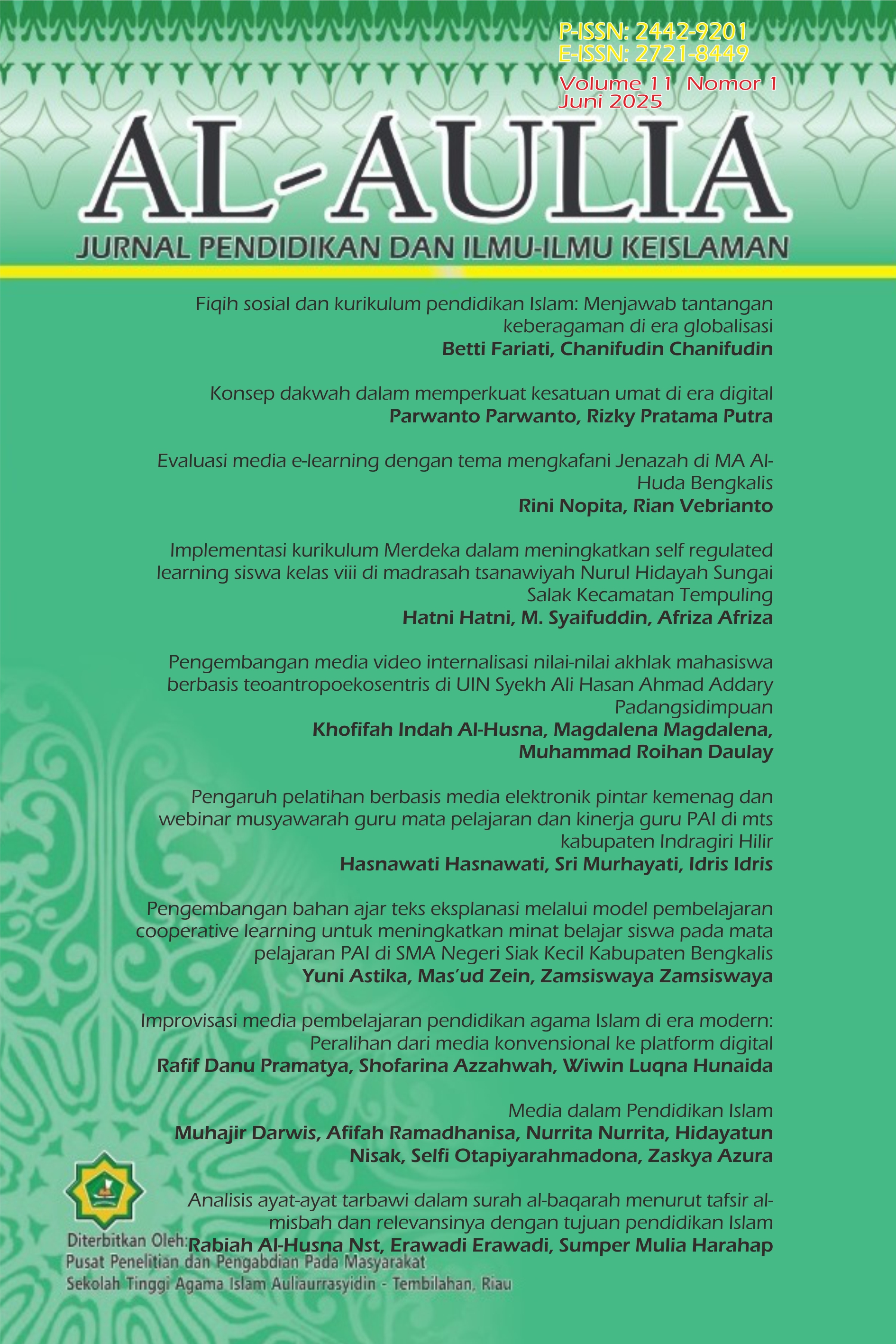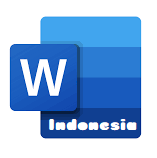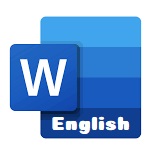Evaluasi media e-learning dengan tema mengkafani Jenazah di MA Al-Huda Bengkalis
DOI:
https://doi.org/10.46963/aulia.v11i1.2601Keywords:
E-learning, Learning Media, Shrouding the CorpseAbstract
Educational media is one of the most important components of the teaching and learning process. The researchers at MA AL-Huda Bengkalis therefore want to develop e-learning resources based on the Sholat Jenazah topic. Using the Research and Development (R&D) technique, 22 teachers and 30 students from class X took part in the study. The researchers directly gathered data through the use of questionnaires and observational techniques. The researchers explained the objectives and purpose of the instruments to the respondents before distributing the questionnaires for them to fill out. Respondents were asked to review the quality of the educational materials utilized and answer questions via the Google Form platform. The gathered data was examined using descriptive analysis.The average score for 30 students on the learning media components was 4.33 with a standard deviation of 0.2, which is also categorized as Strongly Agree, according to the research findings. The average score for 22 teachers was 4.6 with a standard deviation of 0.12. Consequently, it can be claimed that e-learning resources are of exceptionally high caliber, suitable for the current digital age, and built on cutting-edge technology to support interactive learning exercises.
References
Arsyaad, Azhar. 2017. Media Pembelajaran. Jakarta: Rajawali Pers.
Bilson Simamora (2008), Panduan Riset Perilaku Konsumen, PT. Gramedia
Fatimah, D. (2022). Effective use of technology in supervision educational institutions. Indonesian Journal of Education (INJOE), 2(2), 138–149.
Hartono, E. (2012). Pengembangan Media Pembelajaran Berbasis Web untuk Materi Bangun Ruang dan Sisi Datar pada Kelas VIII SMPN 1 Bantul. Skripsi: Fakultas Sains dan Teknologi, Yogyakarta.
Hartanto, W. (2016). Penggunaan e-learning sebagai media pembelajaran. Jurnal Pendidikan Ekonomi, 10(1), 1–18.
Haryadi, Rudi, dkk. 2021. “Pengaruh Media Pembelajaran E-learning terhadap Minat Belajar Siswa”. At-Ta’lim: Jurnal Pendidikan. Vol.7 No.1
Mulyani, W. (2013). Pengaruh pembelajaran berbasis e-learning terhadap hasil belajar siswa pada konsep impuls dan momentum.
Sakdiah.dkk .2022. Implementasi Kahoot sebagai media pembelajaran berbasis Game BasedLearning terhadap Hasil Bealajar dalam Menghadapi Era Revolusi Industri 4.0. Edukatif: Jurnal Ilmu Pendidikan. Vol.4 No1,2022; 487-497
Sapriyah.2019. Media Pembelajaran dalam proses Belajar Mengajar. Prosiding Seminar Nasional Pendidikan FKIP. Vol.2 No1,2019;470-477. Bandung
Setiawan, Ahcmad.2018. Media Pembelajaran inovatif dan pengembangannya. Bandung: Remaja Rosdakarya
Setyoningsih. (2015). E-learning: pembelajaran interaktif berbasis teknologi informasi. Tersedia:https://journal.iainkudus.ac.id/index.php/elementary/article/viewFile/1443/1319 diunduh 1 Juli 2020.
Sohibun, Filza, Yuliana Ade. Pengembangan Media Pembelajaran Berbasis Virtual Class Berbantuan Google Drive. Tadris: Jurnal Keguruan dan Ilmu Tarbiyah,
Subyantoro.A, Suwarto FX. 2019. Metode dan teknik peneltian sosial. Yokyakarta; Andi
Sugiyono, 2015. Metode Penelitian Kuantitatif Kualitatif dan RND. Bandung: Alpabeta.
Suhara, Permana, & Firmansyah. Pernerapan e-learning scorative dalam pembelajaran bahasa. Tersedia: http://ejournal.stkipsiliwangi.ac.id/index.php/semantik/article/view/1476. Diunduh 1 Juli 2020.
Sukmadinata, N. S. (2011). Metode penelitian pendidikan. Bandung: PT Remaja Rosdakarya.
Sutedjo, B. 2002. E-Education, Konsep, Teknologi dan Aplikasi Internet Pendidikan.Yogyakarta.
Syahrum, dan Salim. “Metodologi Penelitian Kuantitatif.” Metodologi Penelitian Kuantitatif, 2012.
Trianto, 2010. Mendesain Model Pembelajaran Inovatif Berorientasi-Progresif. Jakarta: Kencana.
Yazdi, M. 2012. E-Leraning Sebagai Media Pembelajaran Interaktif Berbasis Teknologi Informasi. Jurnal Ilmiah Foristek. Sulawesi Tengah: Fakultas Matematika Dan Ilmu Pengetahuan Alam Universitas Tadulako.
Wahyudi, I. (2017). Pengembangan program pembelajaran fisika sma berbasis e-learning dengan schoology. Jurnal Ilmiah Pendidikan Fisika Al-BiRuNi, 6(2), 187-199
Wahyuningsih, D., dan R. Makmur. 2017. E-Learning Teori Dan Aplikasi. Bandung: Informatika
Wahyuni, T., Wahyuni, S., & Yushardi, Y. (2017). Pengembangan modul multimedia interaktif berbasis e-learning pada pokok bahasan besaran dan satuan di SMA. Jurnal Pembelajaran Fisika, 6(4), 404-410.
Utami, R. P., Rosidin, U., & Wahyudi, I. (2017). Pengaruh Penggunaan E-Learning Dengan Schoology Materi Gravitasi Newton Terhadap Hasil Belajar Siswa. Jurnal Pembelajaran Fisika, 5(2).
Yulita, A. R., Ambarwulan, D., & Bakri, F. (2018). Pengembangan E-Learning Menggunakan Chamilo Untuk Membantu Proses Pembelajaran Fisika SMA Kelas X Semester II. Gravity: Scientific Journal of Research and Learning Physics, 4(2).
Downloads
Published
Issue
Section
License
Copyright (c) 2025 Rini Nopita, Rian Vebrianto

This work is licensed under a Creative Commons Attribution-ShareAlike 4.0 International License.
Authors who publish with this journal agree to the following terms:
1. Copyright on any article is retained by the author(s).
2. The author grants the journal, right of first publication with the work simultaneously licensed under a Creative Commons Attribution License that allows others to share the work with an acknowledgment of the work’s authorship and initial publication in this journal.
3. Authors are able to enter into separate, additional contractual arrangements for the non-exclusive distribution of the journal’s published version of the work (e.g., post it to an institutional repository or publish it in a book), with an acknowledgment of its initial publication in this journal.
4. Authors are permitted and encouraged to post their work online (e.g., in institutional repositories or on their website) prior to and during the submission process, as it can lead to productive exchanges, as well as earlier and greater citation of published work.
5. The article and any associated published material is distributed under the Creative Commons Attribution-ShareAlike 4.0 International License







